linda fantuzzo Framing a Vision by Betsy Fleming
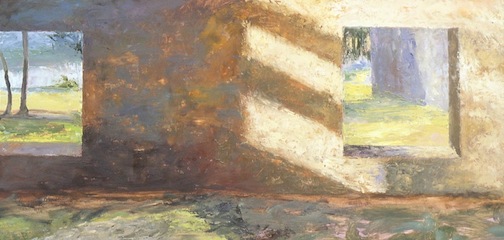 |
| WITHIN THE RUINS 8x16 |
The Gibbes Museum of Art opened the exhibition Framing a Vision: Landscapes by Linda Fantuzzo and Manning Williams on October 10, 2004. Featuring artists of the Lowcountry region who have both trained at the Pennsylvania Academy of Fine Arts in Philadelphia and achieved acclaim on the national scene, this dynamic exhibition examines the relevance of landscape painting in contemporary culture, and more specifically the use of that genre to represent personal and public visions of the Lowcountry. Framing a Vision: Landscapes by Linda Fantuzzo and Manning Williams will be on view in the Main Gallery of the Gibbes Museum of Art through January 2, 2005.
Linda Fantuzzo (American. b. 1950) and Manning Williams (American. b.1939), both Charleston artists boasting successful, prolific careers, cross paths in their academic training and preference for landscape as subject matter. Differing greatly in their choice of media and stylistic approaches, Fantuzzo and Williams come together with a shared high level of skill that reflects parallels in their strong classical training and enduring romance with landscape.
Framing a Vision: Landscapes by Linda Fantuzzo and Manning Williams features approximately forty works that showcase the artists' different approaches to rendering Lowcountry terrain and atmosphere, as well as the sensations and stories contained therein. This exhibition is the first show at the Gibbes co-curated by the Museum's Executive Director Betsy Fleming and Chief Curator Angela Mack.
"While both artists have been featured in numerous solo exhibitions and general group shows, this exhibition presents the first opportunity to examine the ties, as professional colleagues and friends, between Fantuzzo and Williams," explains Executive Director Betsy Fleming. "Having known each other at the Pennsylvania Academy, painted en plein air together, and encouraged as well as critiqued each other's work in Charleston for the past thirty years, the artists' landscapes represent absolutely unique perspectives but also capture universal experiences within the Lowcountry landscape. The paintings will stir the soul and mind of anyone who loves the land."
Framing a Vision: Landscapes by Linda Fantuzzo and Manning Williams is on view in the Main Gallery of the Museum. This exhibition is made possible through the generous support of an anonymous donor and Kiawah Development Partners.
At age twelve, Linda Fantuzzo received her first set of oil paints from Aunt Jane. During her early years of studying art in the public school system of Endicott, New York, Fantuzzo describes her interest in literally transcribing the subjects discovered in the poetry and novels of English class into painted images. In fact, the first work she recalls creating is a giant, oversized portrait with sad, dark eyes inspired by the poem "Evangeline" by Henry Wadsworth Longfellow. Similarly stirred by John Steinbeck's The Grapes of Wrath, a large, dramatic painting, thirty-six inches square, of two immense, awkward heads followed. When Fantuzzo brought both paintings home, her father questioned edgily "Who are these people!"
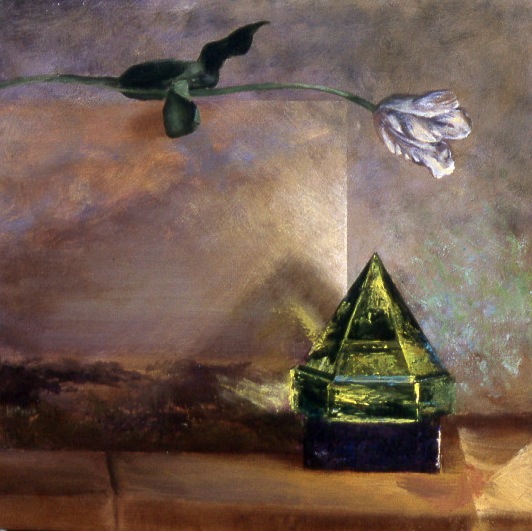 |
| (figure 1) Prism and Tulip 2004 |
For the ensuing forty years, despite having studied at the classical Pennsylvania Academy of Fine Arts and having created in the company of Manning Williams for approximately thirty years, Fantuzzo has refrained from painting people. Such inanimate objects as a deck prism, a bottle, a lantern, pieces of crystal and shale, binoculars, dead butterflies and a tulip stem are her means of populating a space. According to Fantuzzo, the items are "important, in what they are, what life they had, what they bring to me." Each object has its own history, simultaneously intimate, familiar, universal, but of no particular place or period. Prism and Tulip, 2004 is a literal still life that renders objects found in Fantuzzo's studio (figure 1).
As a work of still life, this painting describes the spatial relationships between the objects and particularly the effect of light, shadow and placement in delineating perspective and depth. Geometric shapes are her essential tools for building the composition. This picture, therefore, literally contains a landscape painting and distinct geometrically-shaped forms, while also offering a subjective exploration of geography, especially how one element persuasively placed and rendered may lead a viewer further into the picture plane.
Sometime between 1977 and 1979, during her early years in Charleston, Fantuzzo became deeply focused on still-life painting. That intensity eventually drew her into the landscape. "I was so overwhelmed by the kind of concentration, the sort of intellectuality that was taking place when setting things up, and the landscape painting meant total freedom to me . . . [it] was a way to abandon all the rules and just to work." Fantuzzo's ventures outside the studio were hardly self-directed. In fact, it was Manning Williams, whom she considers her most important mentor and influence, who lured her out-of-doors, saying, "Let's go out and just paint pictures of the landscape. Don't try to make art, just start painting." As Williams would stand in the middle of the marsh, knee-deep in pluff mud, with the wind blowing and his voice roaring, Fantuzzo would select a cool, shady spot, patiently awaiting a breeze and meticulously identifying a small detail of the view to capture in paint. A ready reference, which, to this day, remains in her landscape kit, was a gift from Manning, a small catalogue of paintings by Edwin Dickinson (1891-1978) that immediately inspires a focus on first impressions, loose brushstrokes and painterly freedom.
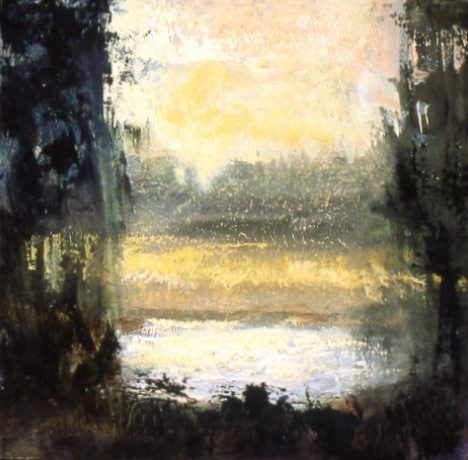 |
| (figure 2) Dark Frame 18x18 |
Created during such outdoor ventures are Fantuzzo's numerous small, quick landscapes on board, measuring five, ten or twelve inches square, including The Lock, 1992 and an eight-by-sixteen inch version of Within the Ruins, 1998 (figure 2). Apparent in these immediate oil studies is Fantuzzo's precise positioning that enables her to construct a landscape vision in a manner very similar to her still-life compositions. In the mid-to-late 1970s, Fantuzzo worked with the house-painting firm, Manning Williams and Company, and as a sign painter with Terry Sign Company in order to support her studio. As a commercial painter, Fantuzzo earned the nickname "Linda Winda" because of her ability to cut a straight edge around a window with great speed and accuracy. This interest in windows certainly connects to her meticulous way of seeing and rendering still life, but has likewise followed her into the landscape. Such paintings as Within the Ruins, 1998 and Interior Light, 2001(figure 3), contain precisely cut windows and thruways.
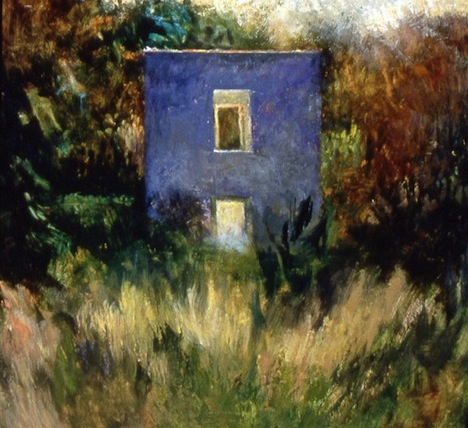 |
| (figure 3) Interior Light 30x30 |
These architectural constructions are significant formal devices for providing depth, varying space and/or surface, introducing light and studying shadow. Additionally, the depicted ruins with windows intimate the picturesque landscape tradition of the nineteenth-century America.
While certainly conveying a sense of presence within the landscape, Fantuzzo's pictures within pictures suggest distance. She is an intuitive witness, not an active participant. Recently, her windows have evolved into abstract, even fuzzy framing elements. The works, Soft Window, 2003 and Dark Frame, 2003, demonstrate a softening of her sharp focus in rendering such tactile elements as the frame and marshland in the distance. While formal geometric elements continue to delineate space in these more abstract works, her early literalism gives way to a more subjective, emotive interpretation of seeing and experiencing nature.
In Fantuzzo's Open Window of 1991, a canister propped on the exterior ledge rests gently against the right window, as if quietly forcing it open. With the window ajar, a soft exterior light seeps into the room, onto the interior window ledge. This interior infiltration creates a path for a viewer to move beyond the interior space. Open Window, 1991 could serve as a metaphor for Fantuzzo's painting of landscape. Something outside herself and her studio, the light, the insistence of Manning Williams, the freedom of space, drew her beyond the studio window and into landscape. Similarly, pathways in her paintings entreaty viewers not only to move through the window, but deep within the Lowcountry terrain she depicts.
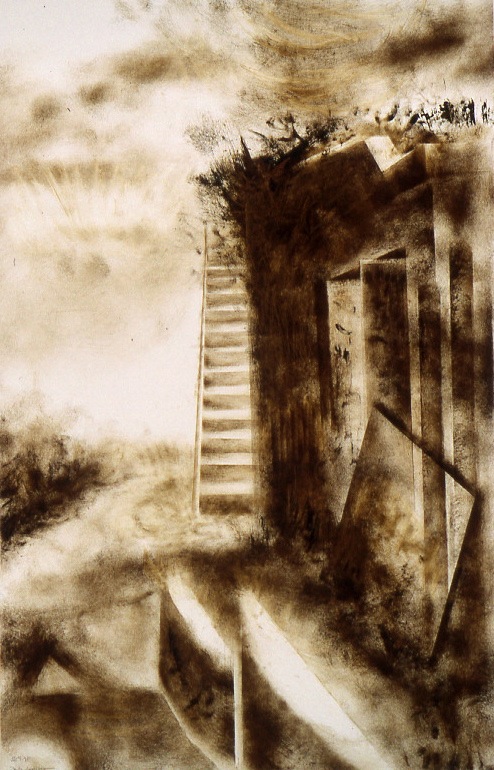 |
| (figure 4) Ascension 40x26 |
Fantuzzo's use of such stylistic conventions as paths, including stairways, roads and waterways that lead from foreground into background, flat horizon lines and single vanishing points certainly draws directly from the nineteenth-century tradition of landscape painting. Her works are, however, uniquely picturesque in the frequent use of manmade elements, but not Man himself, to establish scale and to initiate one's journey into the landscape. Positioned on the edge of a cliff or possibly an abandoned fortress, a staircase rises through the center of the dry-brush drawing Ascension, 1998, leading to what appears an overgrown terrace of land (figure 4). Foreboding yet engaging, the romantic image entices one through the familiar, if decayed, architectural elements and onto the unfamiliar natural platform in the distance.
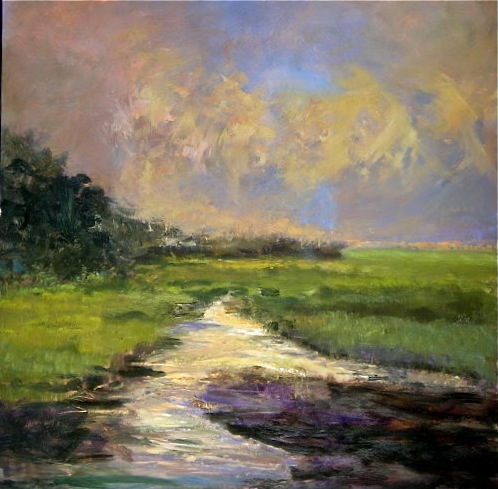 |
| (figure 5) X-Marsh 48x48 |
The waterway is Fantuzzo's most frequently employed representational device for progressing into the depth of landscape. While many of her small oil sketches need that manmade element to mediate between studio and natural expanse, her large-scale landscape paintings, for example Soft Marsh Grass, 2004, Evening at Cougar Island, 2000 and X Marsh, 2004 (figure 5), have abandoned the docks, locks and stairways and, instead, rush a viewer at full force into the textures, atmosphere, warm light and flat distance of the coastal Lowcountry. Similar in construction, these significant paintings feature a stream that touches the bottom edge of the canvas and advances, with various calculated turns, through the picture plane. Geometry, particularly the triangle, plays an important role in realizing the deep geography of the space and assuring a universal appeal. Fantuzzo considers the work of George Inness (1825-1894) as an inspiration for the large landscapes created in the studio. She claims: "Like Inness, I like to use my memory of a place. It is more than identifying a locale. It's more about the feeling that was experienced there, more about a kind of spirit that existed there at the moment, at the time, and then it's also about the abstract qualities . . .finding those squares, those triangles."
In the creation of such recent works as Soft Marsh Grass, 2004 and X Marsh, 2004, Fantuzzo continually negotiates specific and general, representational and abstract. The aim is to render a subjective interpretation of the experience of nature. The resulting work is formally composed, yet emanates a sensation of freedom; appears informed and in step with tradition, yet refreshingly original. It is evident that the actual waterways of the Lowcountry provide Fantuzzo, as initially guided by Williams, with a pathway to rendering a universal landscape. It is fitting that such a vision be drawn out of the South -- that place in the United States with such longstanding cultural, emotional and economic ties to the land.
